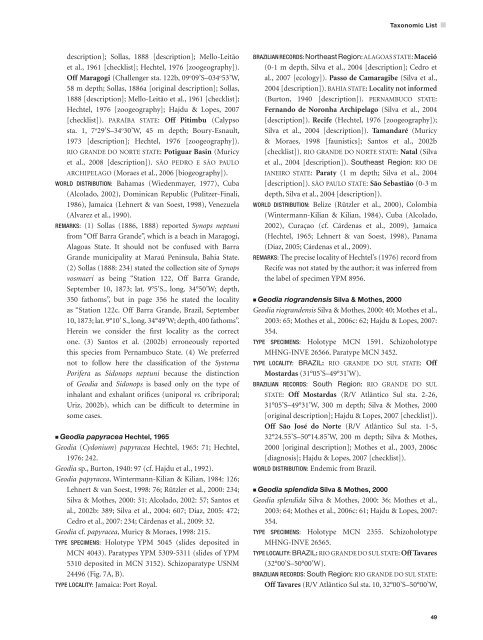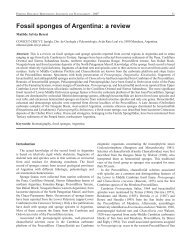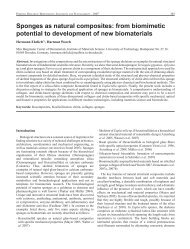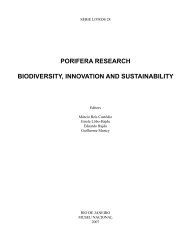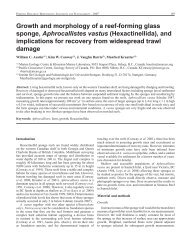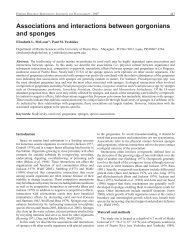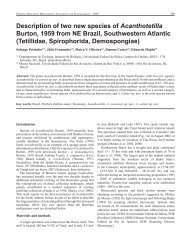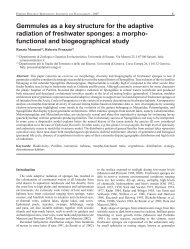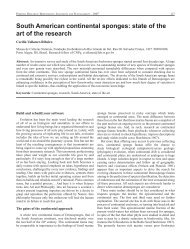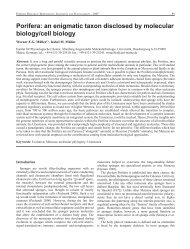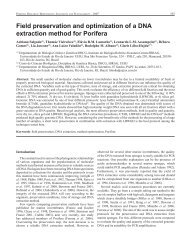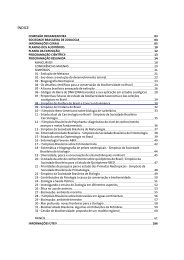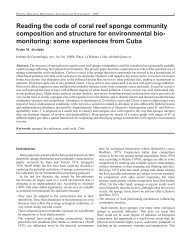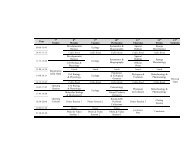Taxonomic Listdescription]; Sollas, 1888 [description]; Mello-Leitãoet al., 1961 [checklist]; Hechtel, 1976 [zoogeography]).Off Maragogi (Challenger sta. 122b, 09 o 09’S–034 o 53’W,58 m depth; Sollas, 1886a [original description]; Sollas,1888 [description]; Mello-Leitão et al., 1961 [checklist];Hechtel, 1976 [zoogeography]; Hajdu & Lopes, 2007[checklist]). Paraíba State: Off Pitimbu (Calypsosta. 1, 7 o 29’S–34 o 30’W, 45 m depth; Boury-Esnault,1973 [description]; Hechtel, 1976 [zoogeography]).Rio Grande do Norte State: Potiguar Basin (Muricyet al., 2008 [description]). São Pedro e São PauloArchipelago (Moraes et al., 2006 [biogeography]).WORLD DISTRIBUTION: Bahamas (Wiedenmayer, 1977), Cuba(Alcolado, 2002), Dominican Republic (Pulitzer-Finali,1986), Jamaica (Lehnert & van Soest, 1998), Venezuela(Alvarez et al., 1990).REMARKS: (1) Sollas (1886, 1888) reported Synops neptunifrom “Off Barra Grande”, which is a beach in Maragogi,Alagoas State. It should not be confused with BarraGrande municipality at Maraú Peninsula, Bahia State.(2) Sollas (1888: 234) stated the collection site <strong>of</strong> Synopsvosmaeri as being “Station 122, Off Barra Grande,September 10, 1873; lat. 9°5’S., long. 34°50’W; depth,350 fathoms”, but in page 356 he stated the localityas “Station 122c. Off Barra Grande, Brazil, September10, 1873; lat. 9°10’ S., long. 34°49’W; depth, 400 fathoms”.Herein we consider the first locality as the correctone. (3) Santos et al. (2002b) erroneously reportedthis species from Pernambuco State. (4) We preferrednot to follow here the classification <strong>of</strong> the Systema<strong>Porifera</strong> as Sidonops neptuni because the distinction<strong>of</strong> Geodia and Sidonops is based only on the type <strong>of</strong>inhalant and exhalant orifices (uniporal vs. cribriporal;Uriz, 2002b), which can be difficult to determine insome cases.K Geodia papyracea Hechtel, 1965Geodia (Cydonium) papyracea Hechtel, 1965: 71; Hechtel,1976: 242.Geodia sp., Burton, 1940: 97 (cf. Hajdu et al., 1992).Geodia papyracea, Wintermann-Kilian & Kilian, 1984: 126;Lehnert & van Soest, 1998: 76; Rützler et al., 2000: 234;Silva & Mothes, 2000: 31; Alcolado, 2002: 57; Santos etal., 2002b: 389; Silva et al., 2004: 607; Diaz, 2005: 472;Cedro et al., 2007: 234; Cárdenas et al., 2009: 32.Geodia cf. papyracea, Muricy & Moraes, 1998: 215.TYPE SPECIMENS: Holotype YPM 5045 (slides deposited inMCN 4043). Paratypes YPM 5309-5311 (slides <strong>of</strong> YPM5310 deposited in MCN 3152). Schizoparatype USNM24496 (Fig. 7A, B).TYPE LOCALITY: Jamaica: Port Royal.BRAZILIAN RECORDS: Northeast Region: Alagoas State: Maceió(0-1 m depth, Silva et al., 2004 [description]; Cedro etal., 2007 [ecology]). Passo de Camaragibe (Silva et al.,2004 [description]). Bahia State: Locality not informed(Burton, 1940 [description]). Pernambuco State:Fernando de Noronha Archipelago (Silva et al., 2004[description]). Recife (Hechtel, 1976 [zoogeography]);Silva et al., 2004 [description]). Tamandaré (Muricy& Moraes, 1998 [faunistics]; Santos et al., 2002b[checklist]). Rio Grande do Norte State: Natal (Silvaet al., 2004 [description]). Southeast Region: Rio deJaneiro state: Paraty (1 m depth; Silva et al., 2004[description]). São Paulo State: São Sebastião (0-3 mdepth, Silva et al., 2004 [description]).WORLD DISTRIBUTION: Belize (Rützler et al., 2000), Colombia(Wintermann-Kilian & Kilian, 1984), Cuba (Alcolado,2002), Curaçao (cf. Cárdenas et al., 2009), Jamaica(Hechtel, 1965; Lehnert & van Soest, 1998), Panama(Diaz, 2005; Cárdenas et al., 2009).REMARKS: The precise locality <strong>of</strong> Hechtel’s (1976) record fromRecife was not stated by the author; it was inferred fromthe label <strong>of</strong> specimen YPM 8956.K Geodia riograndensis Silva & Mothes, 2000Geodia riograndensis Silva & Mothes, 2000: 40; Mothes et al.,2003: 65; Mothes et al., 2006c: 62; Hajdu & Lopes, 2007:354.TYPE SPECIMENS: Holotype MCN 1591. SchizoholotypeMHNG-INVE 26566. Paratype MCN 3452.TYPE LOCALITY: Brazil: Rio Grande do Sul State: OffMostardas (31°05’S–49°31’W).BRAZILIAN RECORDS: South Region: Rio Grande do SulState: Off Mostardas (R/V Atlântico Sul sta. 2-26,31°05’S–49°31’W, 300 m depth; Silva & Mothes, 2000[original description]; Hajdu & Lopes, 2007 [checklist]).Off São José do Norte (R/V Atlântico Sul sta. 1-5,32°24.55’S–50°14.85’W, 200 m depth; Silva & Mothes,2000 [original description]; Mothes et al., 2003, 2006c[diagnosis]; Hajdu & Lopes, 2007 [checklist]).WORLD DISTRIBUTION: Endemic from Brazil.K Geodia splendida Silva & Mothes, 2000Geodia splendida Silva & Mothes, 2000: 36; Mothes et al.,2003: 64; Mothes et al., 2006c: 61; Hajdu & Lopes, 2007:354.TYPE SPECIMENS: Holotype MCN 2355. SchizoholotypeMHNG-INVE 26565.TYPE LOCALITY: Brazil: Rio Grande do Sul State: Off Tavares(32°00’S–50°00’W).BRAZILIAN RECORDS: South Region: Rio Grande do Sul State:Off Tavares (R/V Atlântico Sul sta. 10, 32°00’S–50°00’W,49
<strong>Catalogue</strong> <strong>of</strong> <strong>Brazilian</strong> <strong>Porifera</strong>520 m depth; Silva & Mothes, 2000 [original description];Mothes et al., 2003, 2006c [diagnosis]; Hajdu & Lopes,2007 [checklist]). Santa Catarina State: Locality notinformed (Mothes et al., 2003, 2006c [diagnosis]).WORLD DISTRIBUTION: Endemic from Brazil.K Geodia tylastra Boury-Esnault, 1973Geodia tylastra Boury-Esnault, 1973: 268; Hechtel, 1976:253; Santos et al., 2002b: 389.TYPE SPECIMENS: Holotype MNHN.LBIM.D.NBE 999 (Fig.7C).TYPE LOCALITY: Brazil: Pernambuco State: Off Recife(8 o 15’S–34 o 42’W).BRAZILIAN RECORDS: Northeast Region: Pernambuco State:Off Recife (Calypso sta. 23, 8 o 15’S–34 o 42’W; Boury-Esnault, 1973 [original description]; Hechtel, 1976[zoogeography]; Santos et al., 2002b [checklist]).WORLD DISTRIBUTION: Endemic from Brazil.REMARKS: Boury-Esnault (1973) did not designate typespecimens for this species. We designated here as theholotype by monotypy the single original specimendeposited in the MNHN collection.Family Pachastrellidae Carter, 1875For synonyms see Maldonado (2002).TOTAL OF: GENERA: 5 SPECIES: 8E Characella Sollas, 1886aFor synonyms see Maldonado (2002).Type species: Characella aspera Sollas, 1886a (by originaldesignation).K Characella aspera Sollas, 1886Characella aspera Sollas, 1886a: 187; Sollas, 1888: 92; Mello-Leitão et al., 1961: 16; Hechtel, 1976: 256; Maldonado,2002: 148; Hajdu & Lopes, 2007: 354.Normania goliath Sollas, 1886a: 186 (cf. Sollas, 1888;Maldonado, 2002).Poecillastra aspera, van Soest & Stent<strong>of</strong>t, 1988: 38.TYPE SPECIMENS: Syntypes BMNH 1889.1.1.40-41 (Fig. 7D).TYPE LOCALITY: Brazil: Alagoas State: Off Japaratinga(09°05’S–034°50’W).BRAZILIAN RECORDS: Northeast Region: Alagoas State: OffJaparatinga (Challenger sta. 122a, 09°05’S–034°50’W,640 m depth; Sollas, 1886a [original description]; Sollas,1888 [description]; Mello-Leitão et al., 1961 [checklist];Hechtel, 1976 [zoogeography]; Maldonado, 2002[description]; Hajdu & Lopes, 2007 [checklist]).WORLD DISTRIBUTION: Barbados (van Soest & Stent<strong>of</strong>t, 1988).REMARKS: (1) Maldonado (2002) indicated the slides BMNH1894.11.16.149-150 as the holotype. The Challenger,however, collected two fragments <strong>of</strong> this species, whichare still deposited at the BMNH and should thereforebe designated as syntypes (BMNH 1889.1.1.40-41).(2) Sollas (1886a: 187) indicated the coordinates <strong>of</strong>Challenger station 122a as “lat. 2 o 05’S, long. 34 o 50’W”.We interpreted this as a missprint <strong>of</strong> “lat. 9 o 05’S, long.34 o 50’W”, which are the coordinates <strong>of</strong> this stationindicated everywhere else.K Characella capitolii Mothes, Maldonado, Eckert,Lerner, Campos & Carraro, 2007Characella capitolii Mothes et al., 2007b: 478.TYPE SPECIMENS: Holotype MCN 6926.TYPE LOCALITY: Brazil: Rio Grande do Sul State: Off Tavares(31 o 08.86’S–49 o 32.04’W).BRAZILIAN RECORDS: South Region: Rio Grande do Sul State:Off Tavares (31 o 08.86’S–49 o 32.04’W, 170-173 m depth;Mothes et al., 2007b).WORLD DISTRIBUTION: Endemic from Brazil.REMARKS: The coordinates <strong>of</strong> the collection site werededuced from those originally published (31 o 08’86”S–49 o 32’04”W), which were obviously wrong.K Characella pachastrelloides (Carter, 1876)Stelletta pachastrelloides Carter, 1876: 403.Characella pachastrelloides, Sollas, 1888: 407; Topsent, 1904:95; Boury-Esnault et al., 1994b: 46.Characella sollasi Topsent, 1890: 70; Topsent, 1892a: 40.Poecillastra sollasi, Alcolado, 2002: 57; Hajdu et al., 2004: 184;Hajdu & Lopes, 2007: 355.TYPE SPECIMENS: Unknown.TYPE LOCALITY: “Near Cape St. Vincent” (Porcupine sta. 25, 684m depth [approximately 56 o 45’N–13 o 40’W, 370 km West<strong>of</strong> Scotland; cf. Carpenter et al., 1869]).BRAZILIAN RECORDS: Southeast Region: São Paulo State: OffPeruíbe (REVIZEE Sul sta. 6650, 25º57.39’S–45º34.25’W,417 m depth, Hajdu et al., 2004 [faunistics]; Hajdu &Lopes, 2007 [checklist]).WORLD DISTRIBUTION: NE Atlantic, Azores, Canary Islands, NWFrance, Portugal, N Spain (Carter, 1876; Topsent, 1890,1892a), Ibero-Moroccan Gulf (Boury-Esnault et al.,1994b), Cuba (Alcolado, 2002).REMARKS: Mothes et al. (2007b) expressed serious doubtsabout the identity <strong>of</strong> the <strong>Brazilian</strong> record <strong>of</strong> this speciesand strongly advised its revision.E Dercitus Gray, 1867For synonyms see Maldonado (2002).Type species: Halina bucklandi Bowerbank, 1858.50
- Page 4 and 5: CATALOGUE OFBRAZILIAN PORIFERAGUILH
- Page 6 and 7: SUMMARYAbstract ...................
- Page 8: ABSTRACTAll the literature (486 ref
- Page 12 and 13: I. Introductory Section1. Introduct
- Page 14 and 15: Introductory SectionArticles per De
- Page 16: Introductory SectionRRAPAMPAMACERNA
- Page 19 and 20: Catalogue of Brazilian PoriferaPori
- Page 21 and 22: Catalogue of Brazilian Poriferaof a
- Page 23 and 24: Catalogue of Brazilian PoriferaSUNY
- Page 26 and 27: II. TAXONOMIC LISTPHYLUM PORIFERA G
- Page 28 and 29: Taxonomic ListTYPE LOCALITY: Brazil
- Page 30 and 31: Taxonomic ListREMARKS: The specimen
- Page 32 and 33: Taxonomic ListTYPE LOCALITY: Easter
- Page 34 and 35: Taxonomic ListJapan, and Brazil. Th
- Page 36 and 37: Taxonomic List[description]; Mello-
- Page 38 and 39: Taxonomic List& Peixinho, 1976 [des
- Page 40 and 41: Taxonomic List1999 [faunistics]; Ha
- Page 42 and 43: Taxonomic ListState: Atol das Rocas
- Page 44 and 45: Taxonomic ListK Stelletta crassispi
- Page 46 and 47: Taxonomic ListK Erylus corneus Bour
- Page 48 and 49: Taxonomic List[diagnosis]). Off San
- Page 52 and 53: Taxonomic ListP Dercitus (Stoeba) S
- Page 54 and 55: Taxonomic List63; Amaral et al., 20
- Page 56 and 57: Taxonomic ListKlautau et al., 1994b
- Page 58 and 59: Taxonomic ListDysidea fragilis sens
- Page 60 and 61: Taxonomic ListTYPE LOCALITY: Eritre
- Page 62 and 63: Taxonomic List(REVIZEE sta. C5-2R,
- Page 64 and 65: Taxonomic ListH.M.S. Challenger cre
- Page 66 and 67: Taxonomic ListCliona carteri, Hecht
- Page 68 and 69: Taxonomic Liststate: Guarapari (20
- Page 70 and 71: Taxonomic ListFinali, 1993: 274; R
- Page 72 and 73: Taxonomic ListChondrilla phyllodes
- Page 74 and 75: Plates
- Page 76 and 77: Taxonomic ListFig. 6. Type specimen
- Page 78 and 79: Taxonomic ListFig. 8. Type specimen
- Page 80 and 81: Taxonomic ListFig. 10. Type and rep
- Page 82 and 83: Taxonomic ListFig. 12. Type specime
- Page 84 and 85: Taxonomic ListFig. 14. Type specime
- Page 86 and 87: Taxonomic List1973 [description]; H
- Page 88 and 89: Taxonomic ListSão Paulo State: Sã
- Page 90 and 91: Taxonomic ListE Axinella Schmidt, 1
- Page 92 and 93: Taxonomic ListTYPE LOCALITY: Brazil
- Page 94 and 95: Taxonomic ListTYPE SPECIMENS: Holot
- Page 96 and 97: Taxonomic Listthe Lithistida is wid
- Page 98 and 99: Taxonomic Listet al., 2004b [descri
- Page 100 and 101:
Taxonomic ListCladochalina armigera
- Page 102 and 103:
Taxonomic ListK Chalinula zeae de W
- Page 104 and 105:
Taxonomic List& van Soest, 1998: 91
- Page 106 and 107:
Taxonomic ListSantos et al., 2002b
- Page 108 and 109:
Taxonomic List1988; Lehnert & van S
- Page 110 and 111:
Taxonomic ListK Oceanapia fistulosa
- Page 112 and 113:
Taxonomic List[description]). ARAGU
- Page 114 and 115:
Taxonomic ListState: Caseara, Aragu
- Page 116 and 117:
Taxonomic ListRibeiro & Batista, 20
- Page 118 and 119:
Taxonomic ListK Metania spinata (Ca
- Page 120 and 121:
Taxonomic ListOncosclera navicela,
- Page 122 and 123:
Taxonomic Listdescription]). Manaus
- Page 124 and 125:
Taxonomic List& Pronzato, 2002), Ve
- Page 126 and 127:
Taxonomic ListParaná River (near o
- Page 128 and 129:
Taxonomic List2007b [faunistics]).
- Page 130 and 131:
Taxonomic ListK Heteromeyenia insig
- Page 132 and 133:
Taxonomic ListType species: Heterom
- Page 134 and 135:
Taxonomic Listal., 2003 [faunistics
- Page 136 and 137:
Taxonomic ListWORLD DISTRIBUTION: B
- Page 138 and 139:
Taxonomic ListPará State: Santaré
- Page 140 and 141:
Taxonomic ListRiver (Itaipu H.P.S.;
- Page 142 and 143:
Taxonomic ListMoraes et al., 2006:
- Page 144 and 145:
Taxonomic ListBRAZILIAN RECORDS: So
- Page 146 and 147:
Taxonomic Listfrom those presented
- Page 148 and 149:
Taxonomic ListFortaleza (Johnson, 1
- Page 150 and 151:
Taxonomic ListTYPE SPECIMENS: Holot
- Page 152 and 153:
Taxonomic ListState: Off Guarujá (
- Page 154 and 155:
Taxonomic ListFamily Guitarridae De
- Page 156 and 157:
Taxonomic ListSchizolectotypes USNM
- Page 158 and 159:
Taxonomic List1994: 569; Hajdu, 199
- Page 160 and 161:
Taxonomic ListSuborder Myxillina Ha
- Page 162 and 163:
Taxonomic ListTYPE SPECIMENS: Synty
- Page 164 and 165:
Taxonomic ListWORLD DISTRIBUTION: C
- Page 166 and 167:
Taxonomic List1998: 88; Muricy & Si
- Page 168 and 169:
Taxonomic ListHajdu & Lopes, 2007:
- Page 170 and 171:
Taxonomic Listal., 2006: 166; Cedro
- Page 172 and 173:
Taxonomic ListWORLD DISTRIBUTION: E
- Page 174 and 175:
Taxonomic Listal., 2008 [pharmacolo
- Page 176 and 177:
Taxonomic List(Amapá or Pará (Col
- Page 178 and 179:
Taxonomic ListRegion: Espírito San
- Page 180 and 181:
Taxonomic ListP Hyalonema (Cylicone
- Page 182 and 183:
Taxonomic ListC2-20F (off Linhares,
- Page 184 and 185:
Taxonomic ListFor synonyms see Taba
- Page 186 and 187:
Records Identified Only to Genus Le
- Page 188 and 189:
Records Identified Only to Genus Le
- Page 190 and 191:
Records Identified Only to Genus Le
- Page 192 and 193:
Records Identified Only to Genus Le
- Page 194 and 195:
Records Identified Only to Genus Le
- Page 196 and 197:
Records Identified Only to Genus Le
- Page 198 and 199:
Records Identified Only to Genus Le
- Page 200 and 201:
Records Identified Only to Genus Le
- Page 202 and 203:
IV. LIST OF NOMENCLATORIAL ACTSA sy
- Page 204 and 205:
List of Nomenclatorial ActsHaliclon
- Page 206 and 207:
V. SPECIES NAMES PREVIOUSLY REPORTE
- Page 208 and 209:
Species Names Previously Reported F
- Page 210 and 211:
Species Names Previously Reported F
- Page 212 and 213:
Species Names Previously Reported F
- Page 214 and 215:
Species Names Previously Reported F
- Page 216 and 217:
Species Names Previously Reported F
- Page 218 and 219:
VI. LIST OF SPECIES BY LOCALITYThe
- Page 220 and 221:
List of Species by LocalityPottsiel
- Page 222 and 223:
List of Species by Localityfloridan
- Page 224 and 225:
List of Species by LocalityOff São
- Page 226 and 227:
List of Species by LocalityAcarnus
- Page 228 and 229:
List of Species by LocalityJoão Pi
- Page 230 and 231:
List of Species by LocalityHymeniac
- Page 232 and 233:
List of Species by LocalityEunapius
- Page 234 and 235:
VII. Taxonomic IndexThis index incl
- Page 236 and 237:
Taxonomic Indexarmigera, Callyspong
- Page 238 and 239:
Taxonomic Indexcarteri, Craniella .
- Page 240 and 241:
Taxonomic Indexcunctatrix, Spirastr
- Page 242 and 243:
Taxonomic IndexForcepia (Ectoforcep
- Page 244 and 245:
Taxonomic Indexjanusi, Verongia ...
- Page 246 and 247:
Taxonomic Indexmucronata, Myxilla .
- Page 248 and 249:
Taxonomic Indexplumosa var. palmeri
- Page 250 and 251:
Taxonomic Indexschmidti, Cliona ...
- Page 252 and 253:
Taxonomic Indextoxiformis, Erylus .
- Page 254 and 255:
VIII. REFERENCESRemarks: The articl
- Page 256 and 257:
Referencesdo Cabo - RJ. Revista Pes
- Page 258 and 259:
ReferencesDémosponges du plateau c
- Page 260 and 261:
ReferencesCarter, H.J. (1869) On Gr
- Page 262 and 263:
ReferencesSudamericanas. Comunicaci
- Page 264 and 265:
ReferencesDickinson, M.G. (1945) Sp
- Page 266 and 267:
ReferencesPark, Ceará State, Brazi
- Page 268 and 269:
Referencesinvertebrados marinhos da
- Page 270 and 271:
ReferencesHooper, J.N.A. & van Soes
- Page 272 and 273:
ReferencesSouza, A.O., Galetti, F.C
- Page 274 and 275:
ReferencesRaspailia (Raspaxilla) bo
- Page 276 and 277:
Referencesof the West Indies: Disco
- Page 278 and 279:
Referencese futuro. In: Viana, D.L.
- Page 280 and 281:
References*Muricy, G. & Minervino,
- Page 282 and 283:
References(Brazil) (Tetillidae, Spi
- Page 284 and 285:
Referencesfive new species. Zoologi
- Page 286 and 287:
ReferencesRose, C.S. & Risk, M.J. (
- Page 288 and 289:
ReferencesMit Nachträgen zu den Sp
- Page 290 and 291:
ReferencesSystema Porifera: A guide
- Page 292 and 293:
ReferencesSollas, W.J. (1889) On th
- Page 294 and 295:
ReferencesSociété Scientifique et
- Page 296 and 297:
ReferencesBiodiversity, Innovation
- Page 298 and 299:
References*Volkmer-Ribeiro, C. & Ta
- Page 300:
ReferencesWiedenmayer, F. (1977) Sh


